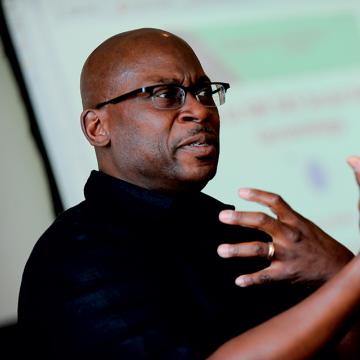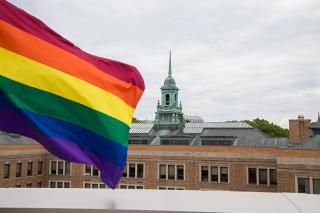December 1 marks the 30th commemoration of World AIDS Day. In honor of 2018's theme, "Know Your Status," Professor Gary Bailey shares his personal experiences and thoughts on the effect of AIDS in the Black community. Learn how education, outreach and being a good friend can help end this disease.

Since 1988, significant progress has been made in response to AIDS. Today three in four people living with HIV globally know their status. But despite this important success, the latest UNAIDS report shows that we still have much more work to do in this area. This includes reaching out to people living with HIV who don't know their status and ensuring that they're linked to quality care and prevention services.
For me, this issue is a personal one — I became actively involved in the 1980’s when many of my friends in Boston’s LBGTQ community began dying from AIDS. One of the earliest losses I experienced occurred in the spring of 1986. I found myself in the intensive care unit at Boston’s Tufts New England Medical Center where I was the only person visiting a very good friend. Five days prior, my friend had been diagnosed with pneumocystis pneumonia — an indicator that he had AIDS. I listened to the respirator that helped him breath and watched helplessly as his life ebbed away. I had no idea that this was not just one heartbreaking loss, but rather the beginning of a period of intense grief that would last for years as countless friends died of the disease. My youth was spent grieving for those who had been lost too young and too soon — and who too few seemed to care about.
In those very early days, the Black community received very little outreach about HIV/AIDS. In fact, it was hard to find any information at all. But then I met Larry Kessler, who had founded the Boston AIDS Action Committee. I first became involved as a volunteer, specifically to inform communities of color that HIV/AIDS was something we needed to pay attention to, and was not a disease that only affected white gay men.
There I met other Black gay men and we formed support groups specifically for this community. It was so desperately needed. Due to the stigma of HIV/AIDS, many of my friends’ families were unwilling to admit what was happening to their sick loved ones. After they died, family members often refused to acknowledge the cause. My friends and I quickly learned to speak in code about “cancer funerals” when we were with our extended families, in our places of worship, or out in the larger community.
When we were in more inclusive and safer gay spaces, such as local gay bars and clubs, we also found that few people wanted to talk about HIV/AIDS. Although the intersection of race and HIV/AIDS was acknowledged at AIDS Action, it was obvious that Black gay men were more likely to get sick and die faster than white gay men. We needed to give each other support and find ways to get around the race-based barriers we faced in accessing information and health care.
People who know better, do better. We owe it to those who didn’t make it, to do what we can now, to end this disease — after all, that’s what friends are for.
Three decades later, that greater vulnerability to HIV among Black gay men still exists. In 2015, the U.S. Centers for Disease Control reported great news: rates of new HIV diagnoses had dropped 19 percent between 2005 and 2015. But new diagnoses were up among Black gay men by 22 percent, and had increased an astounding 87 percent for young Black gay men aged 13-24 years old.
The biased belief that Black gay men are more likely to contract HIV because they take greater sexual risks has been thoroughly debunked by careful study. The simple truth is that the stress of racism continues to play a significant role in the lives of gay men of color, making them more vulnerable to HIV. Historically, Black gay men have had much lower rates of health insurance coverage, and when the coverage was there, implicit bias in some parts of the health care delivery system generally resulted in poorer health outcomes for people of color.
Practically speaking, Black gay men living with HIV are less likely to have suppressed the virus with medication and are more likely to transmit HIV to a sexual partner. This explains the higher rates of HIV among this community.
The work of raising awareness and eliminating barriers to health care and medicine is not over. Getting Black queer men tested and treated with culturally sensitive and informed medical interventions is critical to lowering rates of HIV. It’s also important to encourage sexually active Black gay men who don't have HIV to ask their doctor about pre-exposure prophylaxis (PrEP), an anti-retroviral medication that, if taken daily, makes it nearly impossible to acquire HIV.
Just as important, although more difficult to achieve, is reducing racism and homophobia, both explicit and implicit, among health care providers and support staff. A 2015 study published in the American Journal of Public Health found that nearly 29 percent of Black gay and bisexual men had encountered racist or homophobic behavior in health care settings. As a result, they were much less likely to seek out preventive care, such as HIV testing and treatment, on a timely basis.
People who know better, do better. We owe it to those who didn’t make it, to do what we can now, to end this disease — after all, that’s what friends are for.
Gary Bailey, DHL, MSW, ACSW is the Director of the Urban Leadership Program and Professor of Practice at the Simmons School of Social Work and the School of Nursing. He is a past Board chair of the AIDS Action Committee-Massachusetts; and was a member of the AIDS Action Advisory Council.

